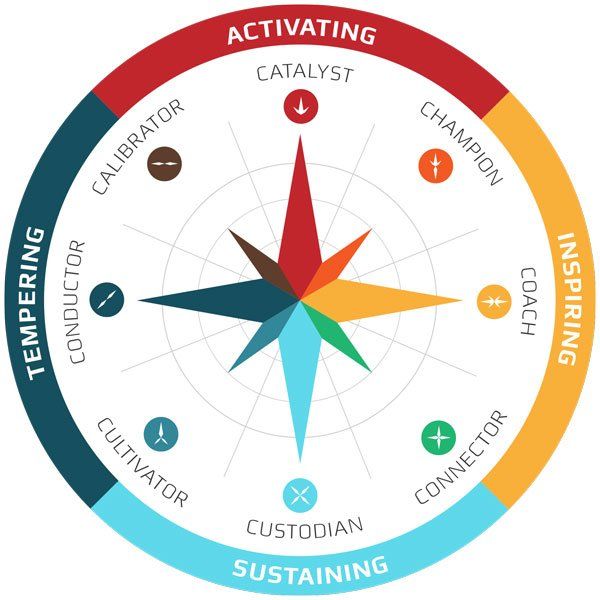GOVERNANCE
UNLOCKING THE NATURAL ENERGY OF YOUR COMPANY
By Belinda Doveston • January/February 2017 • Issue 53
Download PDF Version • 491 KB

In the previous issue we explored the four main ways to use the Contribution Compass
to build effective teams. In this installment we take a new direction — aligning your founders, board and leadership team with the natural energy of the company itself.
So, what is the natural energy of your company? What is the contribution your company is here to make? If your company were a person, how would you best describe them along with their challenges and opportunities?
A meaningful promise
Natural energy indicates the way that you naturally think and operate. It is most easily observed in critical moments, when you will always respond in a particular way. In that critical or defining moment, which is usually a brief and intense pressure or turning point, the decision you make or the action you take dramatically impacts your journey, either positively or negatively.
It is indeed a curious idea that a company can have a specific type of natural energy or even a personality for that matter. There are two ways we can look at this. Firstly, perhaps the natural energy of a company comes from the collective natural energies of its founder(s) or leader(s). This would indicate that a company, as a juristic person, is the sum of its parts or its team. But what if a company is more than that? What if the company, as a juristic person, is a result of what it stands for and the business model it uses to create, capture and deliver its value? As an entity, perhaps it does develop a life of its own and becomes more than the sum of its parts.
My view is that any successful business must, at some point, cross the bridge from being a collection of people to something more than that — to an entity that lives and breathes on its own. Time is an essential ingredient and so is the level of activity and momentum. Yet perhaps the most powerful factor is its unique and purposeful reason for being in existence or what we call, a promise. This promise then translates into a specific business model that, over time, becomes more entrenched and singular.
What we should then see in the maturing organisation is a crystal clear persona that represents how the company creates value and lives its promise. The more this deepens, the greater the chance that, despite new appointments, that persona continues to strengthen its resilience to the influence of the personalities of its individuals, even at board level.
Balanced leadership
My observation has been that in the early stages of an enterprise, the personality of the company is oftentimes the singular result of the personality of its founders. The values are the same, the behaviours are aligned and the essence or core idea is an extension of the founders’ creative potential. As the organisation develops, and perhaps as the next generation of leaders take over, something else might emerge.
On the one hand, the original promise, if powerful and enduring, might deepen and strengthen. Richard Branson’s Virgin Group is a great example of a powerful idea that has deepened over time. Yet, should the idea be ill-formed or no longer relevant, the next generation will have the responsibility of clarifying the business model and forging a new path. McDonald’s and Starbucks are both great examples of businesses that were reinvigorated with a new business model that delivered success. Ray Croc, as a Calibrator profile in his own capacity, transformed McDonald’s into a Calibrator business model, as did Howard Schultz with Starbucks.
Yet for a business to cross the bridge from small business to significant enterprise, it needs much more than a leader aligned to the company’s personality and business model. It also needs a leadership team or board that has a balance of natural energy. When there is a balance of natural energy around a boardroom table or in a leadership team, there is a much more effective flow and, in turn, better results for the executives, directors, board and company. Imbalances at this level will result in polarised and potentially myopic decisions that are swayed by the dominant energy type which will neglect essential diversity.
Identifying, creating and sustaining your value, which you then leverage, is the cornerstone of working effectively with your natural energy. It requires that you have a deep understanding of your natural energy and that you actively seek to utilise that natural energy to create, build and deliver value — for yourself and others. As a founder and business leader it therefore makes sense that in understanding your own natural energy and profile you can unlock a deeper understanding of your company’s business model, its ‘zone of flow’ and the bigger promise or reason for its existence. n
Value creation through natural energy
The Contribution Compass is a profiling methodology that characterises the four main types of natural energy into eight profiles or ‘zones of flow’. Using the Contribution Compass profiles, let’s explore what the eight company personas or profiles would look like and the types of business models and value creation one would typically find.
CatalystA Catalyst creates value through ideas, innovation and product development. This would align well with a company where innovative product design is a critical means of unlocking value. To excel, the company must invest in its product development processes to remain ahead of the pack. Apple is a great Catalyst example.
The Contribution Compass is a profiling methodology that characterises the four main types of natural energy into eight profiles or ‘zones of flow’. Using the Contribution Compass profiles, let’s explore what the eight company personas or profiles would look like and the types of business models and value creation one would typically find.

